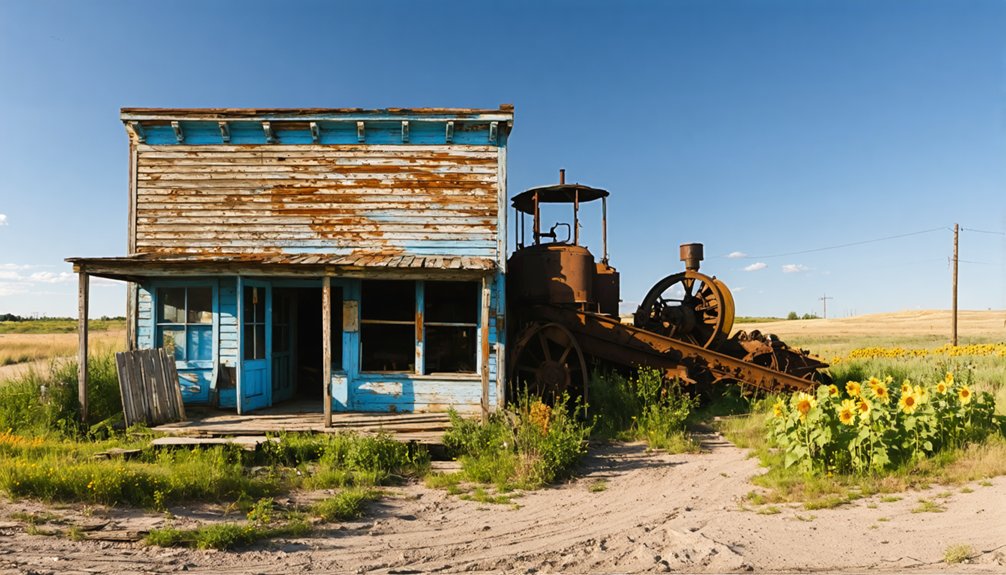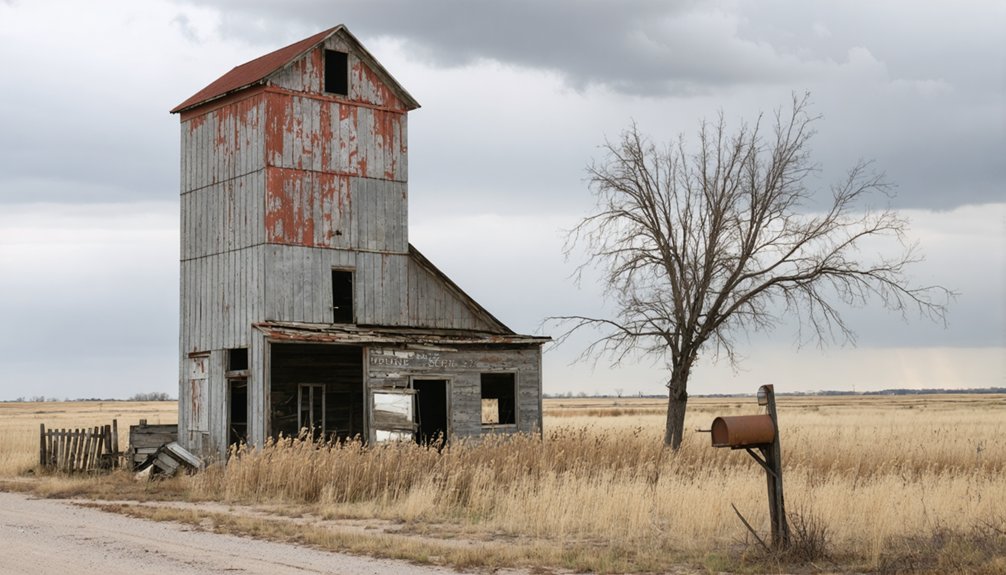You’ll find Gayville, South Dakota near Deadwood, where the Gay brothers established it during the 1876 Black Hills gold rush. The settlement quickly grew to 100 buildings, including theaters and billiard halls, centered around profitable placer mining operations. While the Great Depression and subsequent economic challenges led to its decline, you can still explore the historic remnants and building foundations that tell the story of this once-bustling mining community’s rise and fall.
Key Takeaways
- Gayville was established in 1876 during the Black Hills gold rush by brothers Alfred and William Gay near Deadwood, South Dakota.
- The settlement grew rapidly to include 100 buildings, featuring theaters, billiard halls, and essential services like post offices.
- A devastating economic decline began during the Great Depression, with bank failures and agricultural crises leading to the town’s abandonment.
- Today, Gayville exists as a ghost town with visible foundations and structures from its mining era just miles from Deadwood.
- Visitors can explore the self-guided site, though no formal tourism infrastructure exists and caution is needed around unstable structures.
Origins of Gayville’s Mining Settlement
While many Black Hills settlements emerged during the 1876 gold rush, Gayville established itself as a distinctive mining community near present-day Deadwood, South Dakota.
You’ll find that prospectors were drawn to the area’s rich placer mining opportunities, where gold deposits in streams and gulches promised substantial returns.
The town’s economic development quickly took shape as miners flooded the region. You can trace Gayville’s early growth through its diverse business establishments, including a theatre, minstrel shows, and billiard halls.
The community was founded by the Gay brothers, who established the initial settlement that would grow into a bustling mining town.
J.P. McKinnis’s wholesale and retail grocery operation served as a cornerstone of the community’s commerce.
Though Central City eventually overshadowed its neighbor, Gayville maintained its viability through various amenities and a weekly bus-express service to Deadwood, establishing itself as a resilient frontier settlement.
Like many mining settlements, Gayville’s development violated the Fort Laramie Treaty that had guaranteed the Black Hills to the Sioux.
The Gay Brothers’ Legacy in the Black Hills
When Alfred and William Gay settled in the northern Black Hills in 1876, they established more than just another mining camp – they created a foundation for one of the region’s earliest organized settlements.
The Gay brothers’ contributions extended far beyond their initial placer mining claims in Deadwood Gulch.
You’ll find their influence in Gayville’s rapid development, which grew to include 100 buildings and diverse businesses like theatres, billiard halls, and grocery stores.
Their settlement took place during the time when white settlers increased to around 4,000 people who had moved into the region illegally.
Their mining claim innovations helped establish early infrastructure, including a weekly bus-express service to Deadwood by 1877.
Like other settlements in the area, they witnessed the region’s impressive gold production of $1.5 million in their first year of operation.
While Gayville was eventually overshadowed by Central City, the Gay brothers’ legacy lives on in the transformation they sparked – from simple prospecting to a more sophisticated mining economy that would shape the Black Hills’ development for decades to come.
Economic Rise and Fall During the Depression
The economic hardships of the Great Depression struck Gayville with devastating force, marking a stark departure from the pioneering spirit of its founders.
You’d have witnessed local farmers, once independent landowners, becoming tenants as they struggled to repay World War I expansion loans amid plummeting crop prices. The town’s agricultural crisis began earlier than most realize, as the fall of 1920 marked the start of a devastating economic decline.
While stalwart businesses like the Bagstad and Aaseth Company and The Gayville Observer demonstrated community resilience by maintaining operations, the town couldn’t escape the brutal reality of South Dakota’s devastating bank failures. The Security State Bank managed to reopen, preventing the complete collapse of the local economy.
With 71 banks collapsing across the state and tax revenues plunging, Gayville’s economic foundation crumbled.
Even as federal relief programs arrived between 1929 and 1941, you’d have seen the town’s liveliness slowly drain away, mirroring South Dakota’s position as the lowest-ranking state for annual income by 1933.
Security Challenges and Vigilante Justice
During the darkest days of the Depression, Gayville’s security challenges mounted as bandits repeatedly targeted local businesses, particularly the prominent Bagstad and Aeseth store.
You’ll find that store owners Loyal and Paul Hanson took matters into their own hands, standing guard with shotguns through the night. When formal law enforcement proved inadequate, the town’s residents formed a vigilante organization to protect their livelihoods. Much like modern physical access controls, their presence helped deter potential criminals from entering restricted areas.
The community defense efforts paid off when notorious criminal Le DeLear was found dead after attempting to rob the store.
You can imagine how the townspeople’s resolve strengthened as they installed burglar alarms and organized armed patrols. While these measures reflected the precarious nature of frontier justice, they demonstrated Gayville’s determination to maintain order when traditional law enforcement couldn’t meet their needs.
Life in a Frontier Mining Community
Founded in 1876 by brothers Alfred and William Gay, Gayville rapidly evolved into a bustling frontier mining settlement along a creek gulch in the Black Hills.
The settlement sat at a key intersection of Black Hills mining routes. You’d find daily activities centered around placer mining, where prospectors worked the creek gravels in search of gold. While few struck it rich, most earned modest wages in this seasonal, labor-intensive work. By 1876, miners had claimed virtually all land near productive creek beds, leaving little opportunity for newcomers.
The town’s social fabric wove together through community gatherings at saloons, theatre performances, and minstrel shows. You could find essential services like a post office, blacksmith, and various merchants supplying necessities to the mainly male population.
Living conditions remained basic, with wooden buildings and tents dotting the landscape. The community stayed tight-knit yet transient, as miners often moved on when their claims played out.
The Path to Near-Abandonment
As economic turbulence gripped America in the 1930s, Gayville faced mounting challenges that would ultimately push it toward near-abandonment.
Despite community resilience shown through vigilante groups protecting local stores and the reopening of the town bank, Gayville couldn’t escape the devastating effects of drought, dust storms, and grasshopper plagues that ravaged local agriculture.
You’ll find that improved transportation in the 1940s accelerated rural depopulation, as residents could easily drive to larger towns for shopping and entertainment.
While World War II briefly revived economic activity, it wasn’t sustainable.
The town’s decline mirrored other mining communities in Lawrence County, though unlike many that became complete ghost towns, Gayville maintained minimal economic activity.
Like many towns established along the Chicago and North Western railroad, Gayville’s isolation increased when rail service declined.
The combination of agricultural struggles, reduced mining relevance, and shifting infrastructure ultimately transformed this once-vibrant frontier town.
Historical Significance in South Dakota Mining

While many Black Hills mining settlements faded into obscurity, Gayville played a distinctive role in South Dakota’s early mining history after Alfred and William Gay established it in 1876.
Unlike the industrial-scale operations at nearby Homestake Mine, Gayville specialized in placer mining, where miners extracted gold from creek deposits using traditional methods like sluicing and panning.
You’ll find that community development quickly followed the mining operations, with the town establishing essential services by 1877.
The settlement boasted a theater, billiard halls, and regular bus service to Deadwood. Local commerce thrived through general stores, blacksmith shops, and grain warehouses that served both miners and residents.
Though overshadowed by Central City and Deadwood, Gayville’s contribution to the Black Hills gold rush helped establish the region’s broader mining economy.
Exploring the Remnants Today
Despite its modern sparse population, Gayville retains tangible remnants of its mining-era past that you can explore today. Located just a few miles from Deadwood, you’ll discover historical remnants scattered throughout the landscape, including building foundations and deteriorating structures that survived the devastating 1877 fire and 1883 flood.
During your ruins exploration, you’ll encounter:
- The former site of the historic brewery, once a crucial social hub before the 1883 flood destroyed it
- Visible flood impact zones with scattered debris patterns that tell the story of the catastrophic event
- Mining site remnants that illuminate the town’s gold rush heritage
While there’s no formal tourism infrastructure, you can freely explore the site’s quiet atmosphere, though you’ll want to exercise caution around unstable structures and prepare for variable weather conditions.
Frequently Asked Questions
What Was the Peak Population of Gayville During Its Mining Heyday?
You’ll find that during the mining heyday, Gayville reached approximately 400 people, marking its zenith before mining impact waned and population decline set in, shifting the town’s trajectory downward.
Are There Any Remaining Original Structures Still Standing in Gayville Today?
After a million years of weathering time, you’ll find just two surviving original buildings: the relocated 1873 Hatcher house that’s still occupied and the 1879 Gayville House hotel’s historical preservation.
Did Any Famous Historical Figures Ever Visit or Live in Gayville?
Based on available historical records, you won’t find any famous visitors or historical figures who particularly lived in or visited Gayville during its mining heyday or subsequent years.
What Specific Minerals or Metals Were Primarily Mined in Gayville?
You’ll find that gold was the primary mineral extracted in the area, with mining techniques focused on both placer deposits from streams and quartz-based ores crushed in the region’s first 1876 mills.
When Was the Last Permanent Resident Recorded Living in Gayville?
You can’t pinpoint a “last resident” for Gayville since it never became fully abandoned. Despite population decline over decades, the town has continuously maintained permanent inhabitants through to the present day.
References
- https://gayvillesd.org/44-2/
- https://www.southdakotamagazine.com/watson-parker-ghost-town-friends
- https://www.sdpb.org/rural-life-and-history/2023-08-28/the-boom-and-bust-of-central-city
- https://en.wikipedia.org/wiki/Gayville
- https://en.wikipedia.org/wiki/List_of_ghost_towns_in_South_Dakota
- https://history.sd.gov/archives/docs/governmentguides/lawrence.pdf
- https://www.ghosttowns.com/states/sd/gayville.html
- https://westernmininghistory.com/towns/south-dakota/gayville/
- https://www.americanhistorycentral.com/entries/black-hills-gold-rush/
- https://en.wikipedia.org/wiki/Black_Hills_gold_rush



